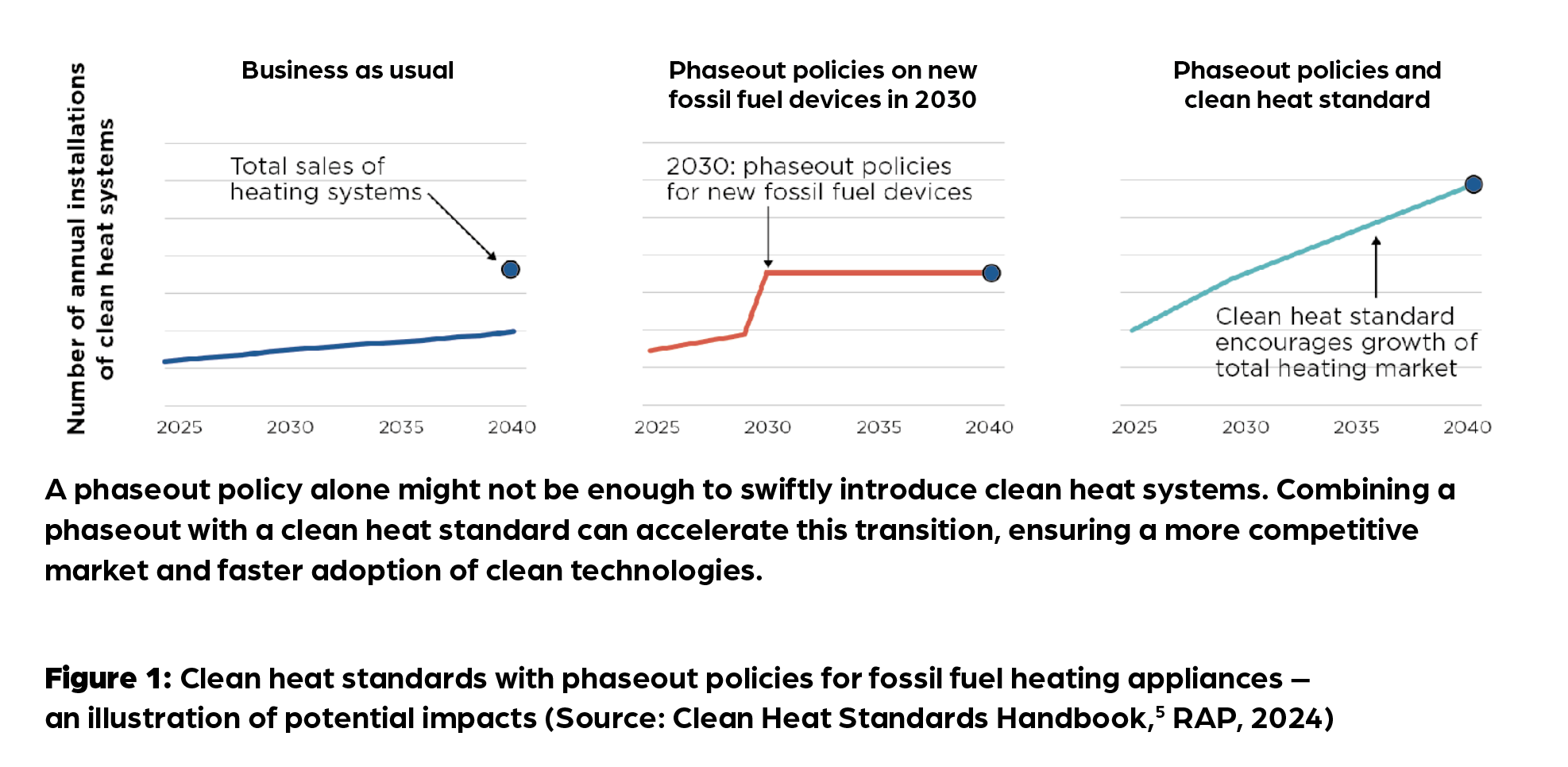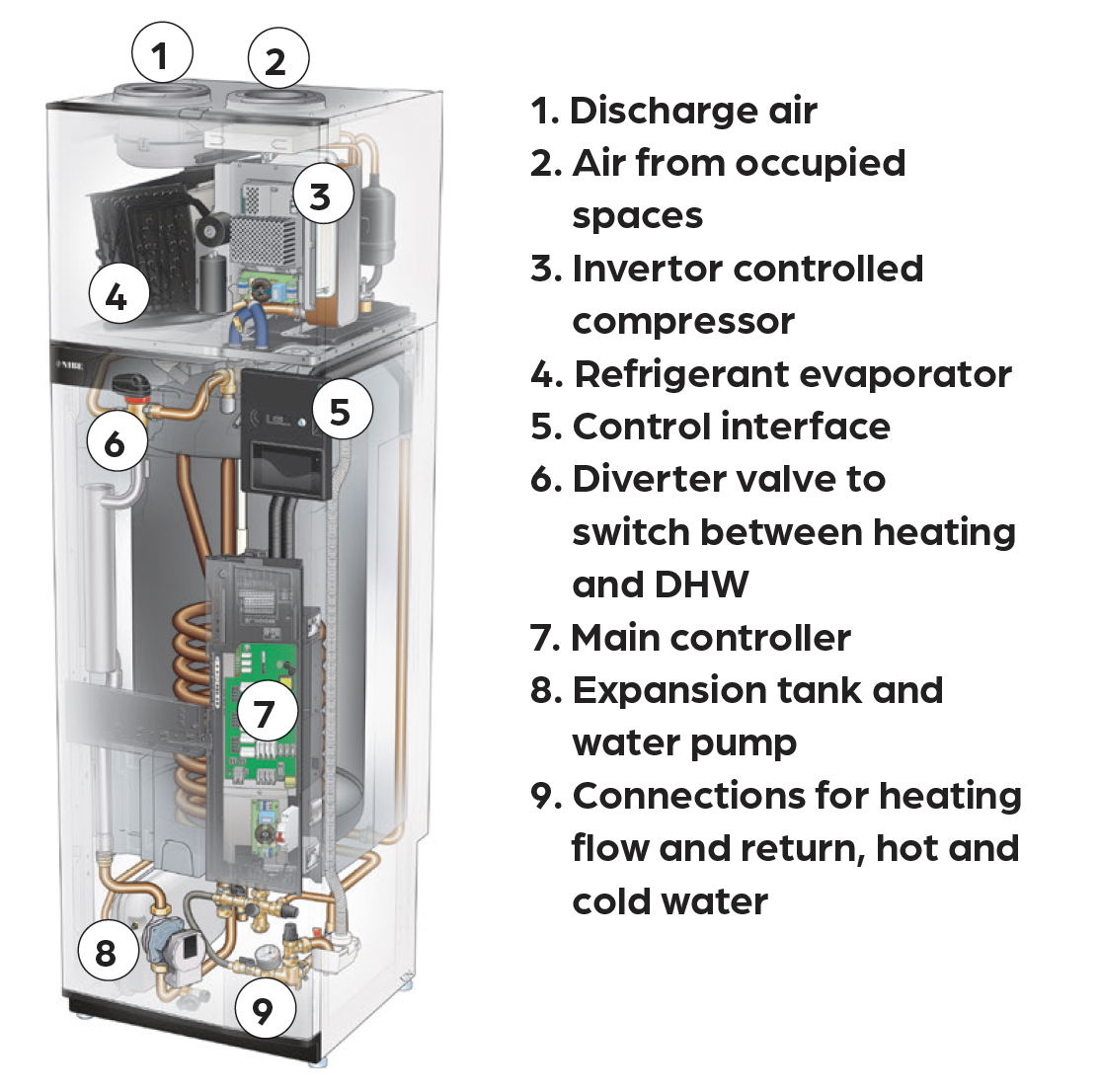
Heat production represents a significant portion of global CO2 emissions. While cost-effective clean heat solutions exist, barriers such as high upfront costs and lack of market certainty hinder their widespread adoption. Successful clean heat standards place an obligation on heating sector participants to deliver cleaner solutions while providing flexibility around how they achieve these targets.
This CPD largely provides a summary of a recently published international handbook that is aimed at accelerating the rollout of suitable clean heat standards across the globe.
Clean heat standards function by placing a performance requirement on key market participants, compelling them to increase the uptake of clean heat solutions. Unlike equipment standards that regulate individual appliances or buildings, clean heat standards target broader fleets of equipment or the operations of energy suppliers. There are several clean heat standards already in place or under development.
In the UK, for example, it is hoped that the Clean Heat Market Mechanism1 (CHMM), which will introduce a rising market standard for heat pumps as a proportion of fossil fuel boiler sales, will be in place in 2025, while, in the US, a few states have embarked on setting sector-specific obligations for energy utilities. A recent report2 by European ‘clean heat’ industry groups drew on an extensive survey3 of 12 EU member states, and determined that the few policy frameworks in place to support wide-scale clean heating and cooling were not yet strong or consistent enough.
To accelerate the design of standards, the Regulatory Assistance Project (RAP)4 – an independent global non-governmental organisation (NGO) – has created a freely accessible handbook5 as a resource for the development of properly considered, holistic clean heat standards. The handbook proposes four steps as a route towards a successful design of a standard.
The first step, ‘Assess the potential role’, emphasises the importance of a thorough evaluation before implementing a clean heat standard. This evaluation should encompass a comprehensive understanding of the existing heat decarbonisation landscape, including the challenges, policy gaps and potential equity implications. This highlights the dominance of fossil fuels in the heating sector as a primary challenge.
While the specific situation varies across jurisdictions, it notes that transitioning to renewable heat requires significant effort, as well as substantial policy and market reforms. Understanding the existing heat consumption patterns across different sectors – such as residential, commercial and industrial – is crucial for determining the scope of a clean heat standard. A nuanced approach is advocated to clean heat solutions, recognising that a single solution might not fit all contexts.
While electrification through heat pumps is often touted as a key pathway, the handbook acknowledges the importance of considering the existing electricity grid’s carbon intensity. In regions with carbon-intensive electricity generation, a rapid and large-scale shift to heat pumps could inadvertently increase emissions. Therefore, policymakers should carefully assess the electricity mix and consider complementary measures, such as accelerating renewable energy deployment in the power sector.
Beyond the technical aspects, the handbook delves into the barriers hindering the adoption of clean heat solutions. These barriers encompass a complex interplay of factors, including high upfront costs for clean heat technologies, challenges in accessing financing – particularly for low-income households – and a lack of awareness or information about available options. It emphasises that addressing equity concerns should commence right from the outset.
Recognising that access to affordable heating is already a challenge for many, policymakers are urged to design clean heat standards that do not exacerbate existing inequalities. This involves understanding the specific needs and barriers faced by vulnerable communities, such as low-income households, renters, and residents of remote areas, and incorporating measures to ensure they benefit from the transition to clean heat.
It acknowledges that there will be a need to critically assess the effectiveness of existing clean heat policies in addressing the identified barriers. This involves evaluating the performance of subsidy schemes, carbon taxes, emissions trading systems, and energy efficiency obligation schemes.
For instance, while subsidies can help offset the upfront costs of clean heat technologies, the handbook cautions that their effectiveness depends on factors such as programme design, accessibility, and the adequacy of funding. Similarly, while carbon-pricing mechanisms can incentivise cleaner choices, their impact on low-income households needs careful consideration, potentially requiring complementary measures to mitigate any regressive effects.
The handbook advocates identifying the specific policy gaps that a clean heat standard would address and how it would complement existing initiatives. For example, while carbon taxes and emissions trading systems provide a price signal, they might not guarantee a specific trajectory for clean heat deployment.

Similarly, phaseout policies can be an effective way to reduce fossil fuel heating system sales, but they might not achieve a rapid, complete replacement, as illustrated in Figure 1. This is because of the long lifespan of heating systems and continued installations before the phaseout takes effect.
A well-designed clean heat standard can provide this missing trajectory, ensuring a predictable and consistent pathway for decarbonising the heating sector. Distributional impacts should be considered, ensuring that the costs of compliance do not disproportionately burden low-income households, and that the benefits of clean heat reach vulnerable communities. Addressing equity concerns may involve incorporating sub-targets for low-income households or designing complementary policies to mitigate potential cost increases.
The second step the handbook proposes, ‘Design the obligation’, outlines the critical considerations for structuring the core requirements of a clean heat standard. This includes determining which market bears the obligation to drive the adoption of clean heat solutions. The focus is provided on two primary categories: energy companies and heating appliance manufacturers.
Energy company targets include gas distribution utilities, providers of delivered fossil fuels (such as heating oil and propane), bioenergy firms and electricity companies. This choice presents complex trade-offs. Targeting upstream companies, such as wholesalers, could offer greater leverage and administrative capacity, but might require navigating interstate commerce regulations, particularly in the US. Conversely, downstream retailers, while benefiting from direct customer interactions, might lack the resources of their larger upstream counterparts.
Targeting heating appliance manufacturers (such as with the UK CHMM) would directly influence the production side of the equation, incentivising manufacturers to ramp up the production of cleaner heating technologies, such as heat pumps.
However, implementing this approach necessitates addressing the potential for importing fossil fuel appliances from regions without similar standards, which could undermine the policy’s intended effects. Additionally, size exemptions may be considered for smaller manufacturers based on sales thresholds, to avoid placing disproportionate burdens on them. Crafting these exemptions carefully is crucial to prevent loopholes that could compromise the standard’s effectiveness.
Establishing a clear and achievable target for clean heat deployment is fundamental to the success of any clean heat standard. The target metric should align with the overarching goals of the standard. For instance, if the primary objective is to reduce greenhouse gas emissions, expressing the target in terms of emissions reductions would be logical.
However, if the focus is on promoting specific technologies, the metric could be tailored to track technology adoption rates. A particular UK initiative (not mentioned in the handbook) is the Boiler Upgrade Scheme (BUS)6 that promises £2bn of grant funding allocated for air source, ground source and water source heat pumps, plus biomass boilers. However, such a technology-prescriptive scheme misses the opportunity of promoting equally valid variants of heat pumps such as exhaust-air heat pumps (EAHPs), an example of which is shown in Figure 2.

Figure 2: An example of an exhaust-air heat pump (EAHP) charged with R290 (propane) delivering heating, hot water and ventilation in one package, with a SCOP of 4.29 and a measured noise level of 49dB(A) (to EN12102). This is aimed at apartments and new-build houses up to 160m2 (Source: NIBE)

While aligning the long-term target with broader climate objectives is vital, there will probably be a need for a phased approach. The initial phases might involve relatively modest targets to allow the market to adapt and avoid sudden cost increases for consumers. Providing certainty about the long-term trajectory and incorporating mechanisms such as banking can encourage continued investment in clean heat solutions.
Beyond setting the overall target, there are additional constraints and sub-targets required to address equity concerns and promote a diverse portfolio of clean heat technologies. Recognising that low-income households often face the greatest barriers to adopting clean heat technologies, sub-targets should be included to ensure that these households benefit from the standard.
These sub-targets could mandate obligated parties to achieve a certain percentage of their clean heat deployments within low-income communities, or offer additional incentives for doing so. This approach helps counteract the risk of clean heat benefits accruing primarily to higher-income households that can more easily afford the upfront costs.
Policymakers can use sub-targets to foster the development of specific technologies deemed crucial for long-term heat decarbonisation, even if those technologies are currently less commercially viable. Conversely, caps can be placed on technologies deemed to have a limited role in the long-term transition, or which pose potential environmental or social risks. For instance, the use of certain biofuels might be capped to mitigate concerns about sustainability and land-use competition.
There must be a transparent and inclusive process for defining eligible actions, potentially allowing for revisions based on technological advancements and market feedback. This iterative approach ensures that the standard remains responsive to emerging technologies and avoids locking in specific pathways prematurely.
Step three in the handbook, ‘Create Flexibilities’, focuses on incorporating flexibility mechanisms into clean heat standard design. Three key flexibility mechanisms are identified:
- Banking and borrowing: This allows obligated parties to adapt to variations in market conditions and project timelines by carrying forward those excess credits to meet future obligations. This incentivises early action and provides a buffer against future uncertainties. Conversely, borrowing allows entities falling short of their targets in a period to defer some of those obligations to the next period – although this needs careful management to prevent delaying overall progress. Setting caps on borrowing and potentially imposing penalties for its use can mitigate this risk.
- Trading compliance credits: Recognising that the cost of implementing clean heat measures can vary significantly across different contexts, these would properly incorporate trading mechanisms. Horizontal trading permits obligate entities to exchange compliance credits among themselves, allowing those achieving reductions at a lower cost to sell credits to those facing higher costs. Expanding the scope to include vertical trading – where accredited non-obligated entities can generate and sell credits – can further enhance cost-effectiveness and stimulate broader market participation in clean heat activities. Establishing clear rules and potentially creating dedicated trading platforms can facilitate efficient market operations.
- Buyouts and alternative compliance mechanisms: Buyout provisions can provide a safety valve for obligated parties facing exceptionally high compliance costs. These provisions allow entities to pay a fee in lieu of directly implementing clean heat measures. However, to prevent buyouts from undermining the standard’s effectiveness, it is crucial to set the buyout price appropriately and, potentially, cap the proportion of obligations that can be met through buyouts. Additionally, dedicating buyout revenues to fund clean heat projects implemented by a designated delivery agent can help ensure that the policy’s overall impact remains aligned with its objectives.
The final stage – step four, ‘Ensure compliance’ – considers the mechanisms that underpin the successful implementation and enforcement of a clean heat standard. There are several key considerations for establishing a robust compliance framework with clear administrative structures.
A specific entity, such as a government agency or regulator, should be designated as the scheme administrator that plays a central role in overseeing the standard’s implementation – including setting detailed rules, managing data collection and reporting, and ensuring compliance with the established framework.
It is important to provide the administrator with the flexibility to adapt to evolving circumstances and refine implementation details through secondary legislation or administrative decisions. This flexibility allows for adjustments based on market dynamics, technological advancements, and lessons learned during the implementation process.
There are actions with directly measurable impacts, such as sales figures for clean heating appliances, and those requiring indirect measurement methods, such as greenhouse gas emission reductions. Indirect methods may include ‘deemed scores’ that assign predefined emission reduction values to standardised clean heat actions.
For instance, a specific type of heat pump installation could be assigned a predetermined emission reduction score based on its technical specifications and average performance estimates. Deemed scores require robust verification mechanisms to prevent gaming the system by prioritising installation speed over quality.
An alternative indirect tool is to employ ‘metered methods’ that rely on actual energy consumption data to determine the impact of clean heat actions. This approach, while more complex and data-intensive, offers greater accuracy, especially for large or complex installations where standardised assumptions might not hold true.
Accounting rules will be required to address the long-term impacts of clean heat actions. This includes assigning appropriate lifetimes to different measures and potentially discounting impacts over time to reflect the time value of emission reductions. Additionally, the rules should provide guidance on addressing the rebound effect, where energy efficiency improvements lead to increased energy consumption owing to changes in consumer behaviour.
Recognising that clean heat standards often operate within a broader policy landscape, any methods should account for additionality – ensuring that the credited emission reductions are genuinely attributable to the clean heat standard rather than other policies or autonomous market trends.
This might involve adjusting targets based on the projected impact of complementary policies or requiring obligated parties to demonstrate the unique contribution of their actions. Effective enforcement mechanisms are crucial for ensuring that obligated parties take their clean heat obligations seriously, and it is important to establish clear and sufficiently stringent penalties for non-compliance.
Setting the penalty price appropriately – high enough to discourage non-compliance but not so high as to be unachievable – is essential. Penalty enforcement should be transparent and prompt, potentially requiring obligated parties to compensate for missed emission reductions in addition to paying financial penalties.
While penalties serve as a deterrent, there is potential for incorporating positive incentives to reward overcompliance and further drive clean heat investments. This could involve financial rewards for exceeding targets or allowing obligated parties to bank excess credits at a premium rate for future use.
By carefully designing and implementing these compliance mechanisms, policymakers can create a robust framework for accountability, transparency and, ultimately, the achievement of clean heat objectives.
In conclusion, the handbook highlights that clean heat standards are promising tools for accelerating the transition to cleaner heating systems, but their success requires a comprehensive policy approach. Policymakers will need to tailor the design of standards to their specific contexts, considering local heating sector characteristics, equity implications, and potential interactions with existing policies.
This will involve addressing barriers to clean heat deployment, ensuring equitable access to affordable solutions, and leveraging market forces through flexibility mechanisms and robust compliance frameworks. l
© Tim Dwyer 2024.
This CPD article is principally drawn from the freely downloadable Clean Heat Standards Handbook5 by Marion Santini and team at the Regulatory Assistance Project.
References:
- bit.ly/CJNov24CPD1 – accessed 6 September 2024.
- How can Europe fill the clean heat gap, bit.ly/CJNov24CPD2 – accessed 6 September 2024.
- bit.ly/CJNov24CPD3 – accessed 6 September 2024.
- bit.ly/CJNov24CPD4 – accessed 6 September 2024.
- bit.ly/CJNov24CPD5 – accessed 6 September 2024.
- bit.ly/CJNov24CPD6 – accessed 6 September 2024.
